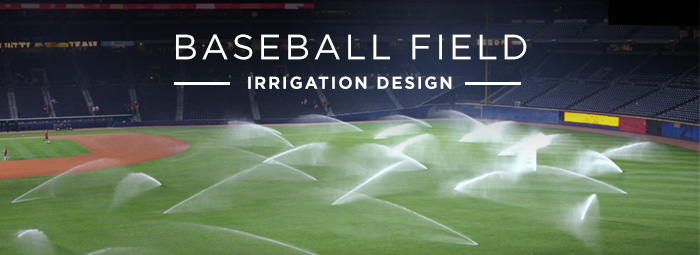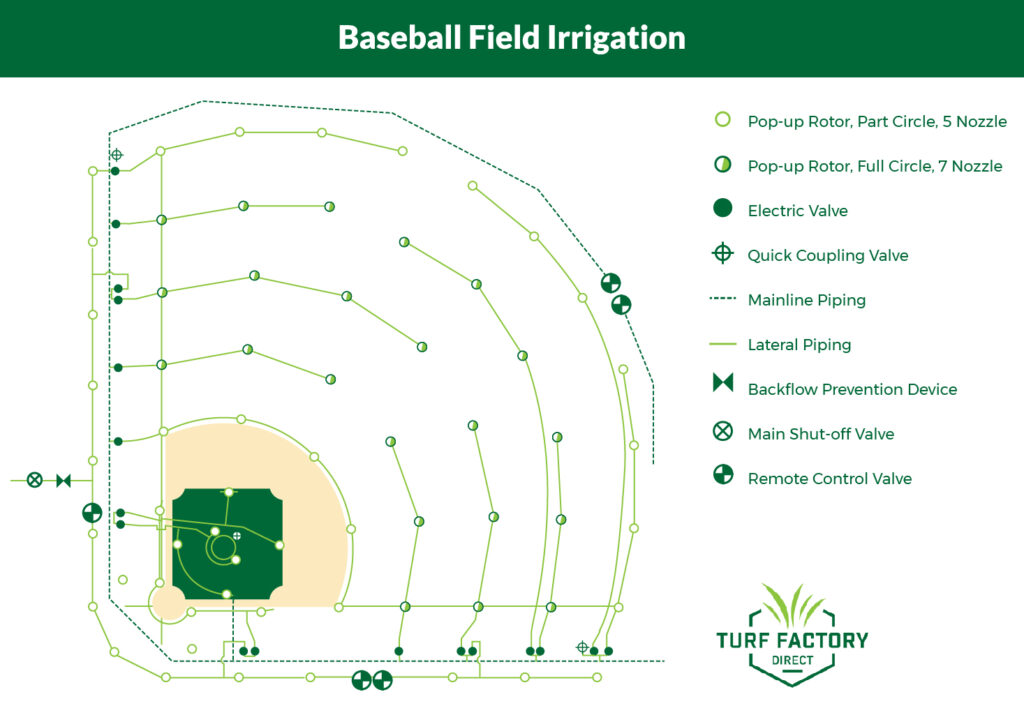
Every baseball team needs a verdant, lush field to play on, and effective irrigation design is paramount for maintaining the grass in that field. Installing a reliable irrigation system throughout your baseball field is crucial to the success of the field and the team’s performance and reputation.
However, a grass baseball field can drain your resources due to the high maintenance costs. On the other hand, artificial turf baseball fields have low maintenance requirements, are attractive, and save water, time, and money. Find out what goes into the design of a baseball field irrigation system, and how turf can save you resources.

6 Irrigation System Components
1) Sprinkler Heads
These devices distribute water evenly over the field. Depending on the size of the field, you can install any number of sprinkler heads.
The common types of sprinkler heads include:
- Fixed heads that spray fixed water streams in the form of water droplets or mist
- Rotor heads spray rotating/multiple streams to effectively cover an extensive area, mostly over 18 ft radius
- Pop-up heads are installed underground or at grade level and emerge when you activate the sprinklers
- Stationary heads spray water to a specific location
2) Valves
Valves control the flow of water through the entire irrigation system. Usually, the water pressure is insufficient to supply water to the entire field at once. The valves divide the field into independent zones, each with an individual valve for optimal water supply.
Often, the valves are installed in groups (manifold) for easier maintenance. They are then housed in a valve box to allow convenient access to the valves and protection from pests, the elements and other destructive factors.
3) Mainline
This is the primary pipe(s) that transports water from the water source (or backflow prevention device) to the valves. This higher quality pipe is constantly pressurized and full of water; hence the maximum pressure rating that’s double the actual static water pressure.
The most common mainline materials include:
- PVC plastic
- Polyethylene (Poly) tube
- PEX tubing
- Metal pipe/tube
4) Lateral Pipes
These carry water from the valves to the sprinkler heads. They don’t need much strength and can be of lower quality since the water in them gets pressurized only when you activate a particular zone and switch on the sprinklers.
5) Flow Sensors
This is a device you install on the mainline to determine how much water flow the irrigation system consumes at particular periods by creating an electronic pulse when a certain water amount flows through it. It’s connected to the irrigation controller that switches the irrigation system on or off.
6) Soil Moisture Sensors
This device determines the amount of moisture in the soil. The device enables irrigation by controlling the water flow depending on the amount of moisture in the soil.
The main types of soil moisture sensors are:
- Matric potential sensor determines the energy plant roots require to source water from the soil
- Volumetric water content sensors measure the volume of water per soil volume
9 Important Factors For Baseball Field Irrigation
Before installing the irrigation system, here are some important factors to consider:
1) Zone Configuration
This is dividing the baseball field into zones and allocating each zone several sprinkler heads and valves. Zone configuration ensures optimum and precise water supply evenly throughout the field. Further, this process saves more water and money.
2) System Pressure
The entire irrigation system depends on the static water pressure. This pressure determines other factors, including the number of zones and sprinkler heads per zone and the pressure on the lateral pipes. Typically, pressures of around 40 – 80 PSI are ideal for the sprinkler heads to perform optimally.
3) Desired Precipitation Rate
Precipitation rate calculates the soil’s water intake and establishes if the sprinkler is dispensing enough water during specified operating times as required, expressed in inches per hour (in/hr). While some manufacturers indicate the precipitation rate, you might need to calculate it if your design doesn’t match the specified criteria:
PR = 96.25 x Total GPM
Total Area (S * L)
Where:
- 96.25 is a constant that converts gallons per minute to inches per hour
- Total GPM is the gallons per minute of water dispensed
- S is the sprinkler head space
- L is the distance between sprinkler rows
4) Head Spacing
The rule of thumb with head spacing is to achieve total overlying of the watered areas. In other words, water from any particular sprinkler should wet the sprinkler on each side (head to head coverage or head to head spacing).
To get the optimal distance between heads, multiply the spray diameter by 0.6. For instance, heads with a spray radius of 18 ft should be 21.6 ft apart: 18 x 2 x 0.6 = 21.6
5) Nozzle Size & Type
For the sprinklers to work effectively, it’s important you get the right nozzle type and size.
Impact Sprayer
Spray heads are convenient as they are compatible with various nozzle types and sizes (not brands), thanks to “matched precipitation rates.” Impact sprayers reach between 40-49 ft and can cover an area of up to 7,542 sq ft. They can be more expensive because they are constructed out of bronze or brass, but they are durable and can last for years.
Rotor Sprinkler
Rotor sprinklers operate by rotating water streams in circles or back and forth over the field. The rule of thumb with rotors is the distance between two heads should be less than the pressure at the rotor head.
So, if you want to place rotors 20 ft apart, the ideal pressure should be 20 PSI. However, considering some pressure is usually lost due to a fraction in the delivery system, you might need 25 PSI for optimal operation.
Rotary heads are the best sprinklers to use in baseball field irrigation systems. They operate above 30 PSI, with an extended spray range (15 ft – 50 ft or more), and lower precipitation rates, saving water and money.
However, each rotor sprinkler requires the appropriate nozzle type and size to attain the desired precipitation rates. The nozzle type and size needed will vary, depending on the pressure and head spacing. Go for a nozzle that matches the pressure to GPM, or at least comes close
6) Traffic
More traffic areas will require more water than less trafficked areas. This is because the grass will be damaged and will need to be replaced more often. Therefore, when setting up the irrigation schedule, it is important to take into account the areas of the field that will be used more often.
7) Cost
Several factors affect the cost of installing an irrigation system for your baseball fields, such as the type and quality of the sprinkler system, labor, permits and the number of zones, to name a few. Not to mention the cost to maintain the irrigation system, and the water it uses.
8) Water Use Efficiency
This is the amount of water that serves the actual purpose of nourishing the grass. Some water is lost due to evaporation, runoff, deeper percolation, wind, and seepage through pipe breaks. Sprinkler efficiencies vary, but they generally range between 60% and 80%, averaging 75%. You want to always use water as efficiently as possible, both to save money and for the benefit of the environment.
9) Irrigation Schedule
The best time to irrigate the field is in the morning before 10 a.m for 20 – 30 minutes a few days a week. That’s when it’s cooler, and the winds are calmer enabling absorption (for natural grass) and reducing evaporation. For efficiency, consider installing an automatic irrigation system where you can schedule watering at optimum periods without manual intervention.
These are just a few of the key factors that you need to keep in mind when designing an irrigation system for a sports field. If you take the time to consider all of these factors, you’ll be well on your way to designing a successful system.
However, instead of installing an irrigation system in your baseball field, you should first consider installing a turf baseball field. Properly installed turf can last years with minimal maintenance, and save you time and money in the long term.
Irrigation Alternative? Artificial Turf Baseball Fields
Did you know that installing artificial turf can reduce your irrigation work and cost by 50%? While there are many people still on the fence about installing artificial turf, the truth of the matter is that artificial turf is cost effective and environmentally friendly. There are many baseball and football stadiums that have already installed artificial turf. In the MLB, 5 fields use artificial turf:
- Rogers Centre in Toronto, Ontario
- Chase Field in Phoenix, Arizona
- Tropicana Field in St. Petersburg, Florida
- Globe Life Field in Arlington, Texas
- Loandepot Park in Miami, Florida
It’s clear that artificial turf is on the rise. For all your artificial turf needs, Turf Factory Direct has you covered! We sell high-quality turf grass for sports fields, including batting cages, soccer, and putting greens, as well as turf for lawns, pets, kids, and interior facilities. Contact us or browse our products for the ultimate baseball field.







